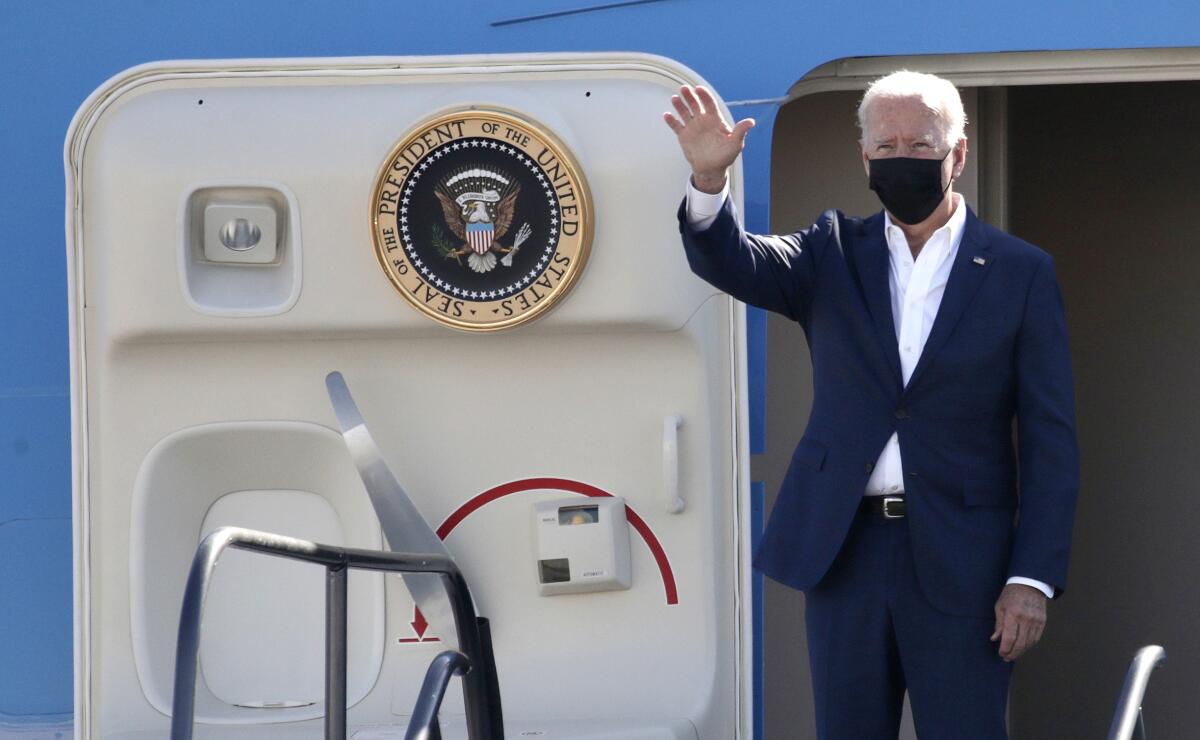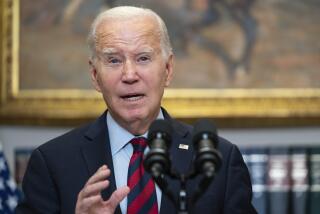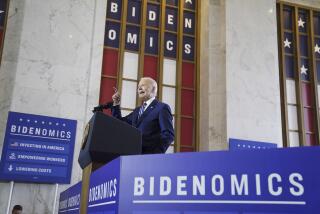Column: There’s more to ‘Build Back Better’ than its price tag

I’ve created a drinking game for watching TV news. It seems the hosts and pundits can’t talk about Democrats’ $3.5-trillion agenda for expanding healthcare, mitigating climate change and investing in housing, education and workers without using the word “massive,” with extra emphasis on the first syllable.
“Democrats’ MAS-sive $3.5-trillion proposal.” Drink!
The M word suggests fiscal irresponsibility, as though President Biden’s “Build Back Better” plan of spending programs and tax cuts were simply reckless. No matter what you think of the program (I think it’s long overdue), perspective is essential. The media often leave it out. And Democrats, rarely good at political messaging, aren’t countering effectively, letting the implication of profligacy go unchallenged.
So it was notable when the president, during two stops in California on Monday to survey wildfire damage and support Gov. Gavin Newsom against the recall attempt, actually offered two main points of perspective about the sum he and most congressional Democrats want to invest in the nation’s physical and human capital.
First, the programs would be spread over a decade, making the cost roughly $350 billion annually on average — still a lot, but not $3.5 trillion in a single year, as one could easily imagine from most news coverage of the price tag. Second, that multitrillion-dollar total is a pittance relative to the 10-year projections of the nation’s growing economic output, according to public and some private forecasts.
As Biden put it during his swing through California, that’s about “five-tenths of 1% of the entire GDP.”
“Thinking small is a prescription for disaster,” he added.
Biden’s message still needs work. In two appearances, he used slightly different figures to describe the economy’s projected growth, the percentage relative to that growth that his agenda would represent, and how much of his package would be “paid for” with offsetting savings and tax increases on the wealthy and corporations. (He first claimed all of it would be paid for, then 90%. Most likely, if Congress passes his plan, it will be smaller than $3.5 trillion, given moderate Democrats’ objections, and the savings and new revenue won’t cover the full cost, given Democrats’ splits on the tax proposals.)
The president and his supporters could better use some other data points to put the massive (drink!) $3.5-trillion figure in perspective. Cite the potential for economic growth as a result of investment in both physical and social infrastructure. Compare the plan to the tax cuts that President Trump and a Republican-controlled Congress enacted in late 2017. And look at the actual pieces of the $3.5-trillion package, which tend to get overlooked amid attention to the bottom line.
While impossible to calculate precisely, economic growth would significantly offset the package’s cost. Congressional Democrats haven’t filled in the details, let alone agreed to them, and certainly some spending could be wasteful. Yet economic studies have shown taxpayers generally get more bang for the buck from public investments like infrastructure spending, nutrition programs and direct assistance to workers than from corporate tax cuts.
Economists at Moody’s Analytics wrote that the Democratic package, together with the smaller, bipartisan infrastructure bill providing about $600 billion for roadways, water projects, mass transit and more, “will strengthen long-term economic growth, the benefits of which would mostly accrue to lower- and middle-income Americans.” The plans would allay the economic consequences of climate change and “lift productivity and labor force growth.”
Contradicting a main Republican talking point, Moody’s said speculation that the plan would ignite inflation and overheat the economy is “overdone.” Instead, “The fiscal support it provides is only sufficient to push the economy back to full employment from the recession caused by the COVID-19 pandemic.”
Now contrast the focus on the bigger bill’s $3.5-trillion price tag with the labeling of the Republican tax cuts during the 2017 debate. Those were described as a $1.5-trillion package, but that was a net figure — after subtracting for spending cuts and tax increases in the mix. The gross figure for those tax cuts was about $5.5 trillion, according to the Center on Budget and Policy Priorities. If the same math were applied to Biden’s plan, its cost would be appreciably less than the gross figure of $3.5 trillion. Also, contrary to Trump and Republicans’ claims, the tax cuts did not spur growth after the economy’s initial sugar high.
And finally, try to see the trees in that $3.5-trillion forest. Republicans focus on the (get ready to drink!) “massive, reckless taxing and spending spree,” as Senate Minority Leader Mitch McConnell of Kentucky called it this week. House Speaker Nancy Pelosi (D-San Francisco) does try to get to the particulars, most of which are hugely popular in polls: “Where would you cut? Childcare? Family medical leave paid for? Universal pre-K? Home healthcare?”
In time for Biden’s California trip, the White House highlighted some other potential gains for the state, including the extension of a child tax credit benefiting 7.8 million children, for an estimated 34% reduction in child poverty, and expansion of Pell Grants for 945,000 Californians in college. Biden underscored others: money for wildfire mitigation projects, clean energy subsidies, affordable housing construction and more.
Is $3.5 trillion massive? So are the nation’s needs.
As Biden said in California, “We can’t afford not to do it.”
More to Read
A cure for the common opinion
Get thought-provoking perspectives with our weekly newsletter.
You may occasionally receive promotional content from the Los Angeles Times.











